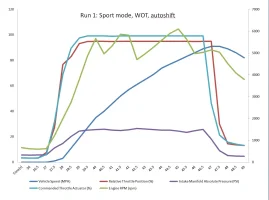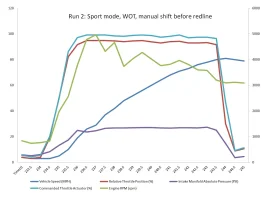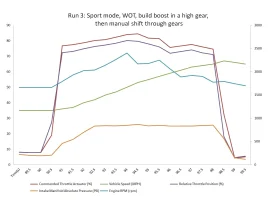DaBears4Lyfe was right, I haven't data logged the throttle position on a Kia Stinger before that point and was going off of videos and automotive experience.
That lead me to decide to verify for myself by taking some data logs and I'm posting the results here. I used my BlueDriver Bluetooth OBDII Reader to log Speed, Engine RPM (so you can see the shift), Boost Pressure, Commanded Throttle Position (gas pedal position), and the actual Throttle body position.
As you'll see in the data, there is there is absolutely NO throttle closure during shifts in my 2019 Kia Stinger GT1 that I drove. I have over a dozen runs logged and none of them show any throttle body closures. This is further evidenced by the fact that Boost pressure remains constant through the shift (hence, no blow off sound).
Run 1 was from a dead stop. Wide Open Throttle (WOT) all the way to 90mph. Car was in Sport mode, traction control was still on and was in standard automatic shifting. Note the boost and throttle position remain constant during the acceleration period. Boost pressure finally drops once I let off on the gas.
Run 2 was from a dead stop. Also WOT all the way to the end except I was in Sport mode with Manual shifting. I manually shifted before the redline as you can see the 5 shifts I did by looking at the engine RPM drops. Note the boost and throttle position remain constant.
Run 3 was from about a 35mph roll in 5th gear, manual mode, and gunning it to build boost then manually shifting. Note the boost and throttle position remain constant through the shifts.
Bottom line, on a automatic car like ours, unless the stock valve is leaking, you won't see any benefit in an upgraded one during shifts, as the valve remains closed the whole time.








